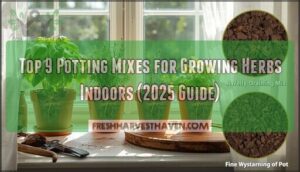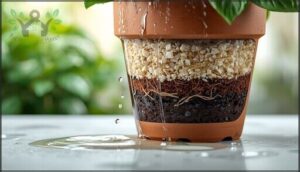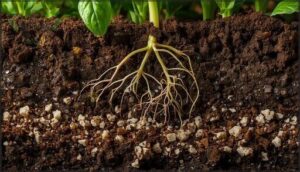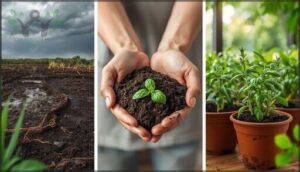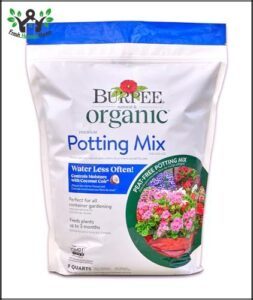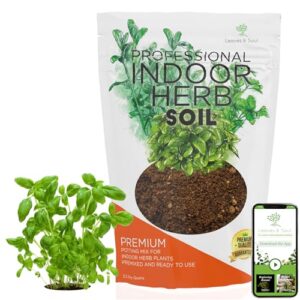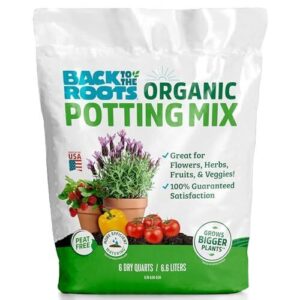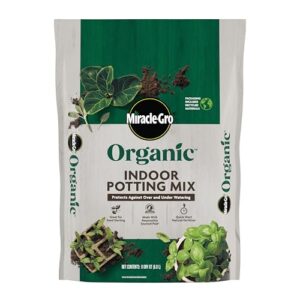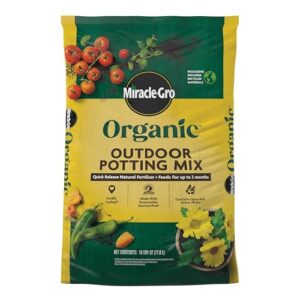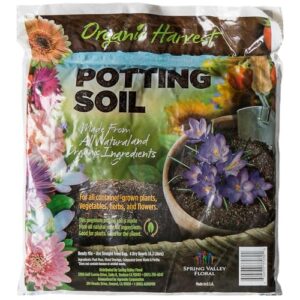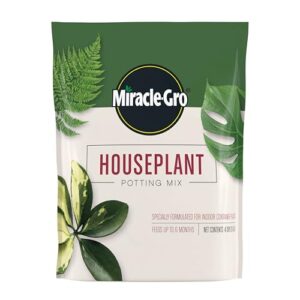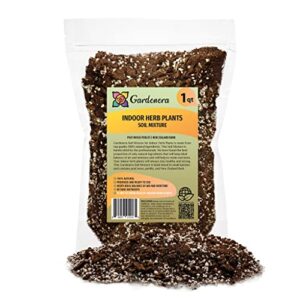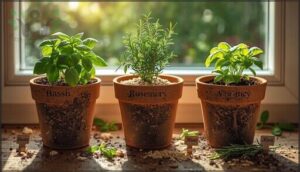This site is supported by our readers. We may earn a commission, at no cost to you, if you purchase through links.
Your herbs won’t thrive in regular garden soil, no matter how carefully you water them. Indoor containers create a completely different growing environment than outdoor beds—one where drainage becomes critical and compaction turns deadly.
The difference between wilted basil and a thriving windowsill garden often comes down to what’s happening below the surface, where roots either spread freely through airy, well-structured medium or struggle against dense, waterlogged earth.
Choosing the right potting mix for growing herbs indoors means understanding how these plants actually grow in containers, then matching their needs to the specific characteristics each formula offers. The best mixes balance moisture retention with drainage, provide steady nutrition without overwhelming delicate roots, and create the aerated structure that indoor herbs depend on to flourish year-round.
Table Of Contents
- Key Takeaways
- Key Factors in Choosing Indoor Herb Soil
- Essential Soil Characteristics for Indoor Herbs
- Top 9 Potting Mixes for Growing Herbs Indoors
- 1. Burpee Premium Organic Potting Soil Mix
- 2. Indoor Herb Plant Soil Mix
- 3. Back to the Roots Organic Potting Mix
- 4. Doter Organic Potting Soil Mix
- 5. Miracle Gro Organic Indoor Potting Mix
- 6. Miracle-Gro Organic Outdoor Potting Mix
- 7. SuperMoss Agromin Organic Potting Soil
- 8. Miracle-Gro Houseplant Potting Mix
- 9. Gardenera Indoor Herb Planter Soil Mix
- How to Match Potting Mix to Herb Types
- Tips for Maintaining Healthy Indoor Herb Soil
- Frequently Asked Questions (FAQs)
- Conclusion
Key Takeaways
- Indoor herbs need potting mixes with 25-33% perlite for drainage and 20-35% coir or peat for moisture retention, as regular garden soil causes root rot and compaction in containers.
- Organic mixes with slow-release fertilizers and mycorrhizae deliver up to 63% better nutrient availability and can feed herbs for 2-6 months without additional supplementation.
- Mediterranean herbs like rosemary and thyme require at least 30% sand or grit in their mix and a pH between 6.5-8, while moisture-loving herbs like basil and mint thrive in nutrient-rich blends with balanced drainage at pH 6.0-7.0.
- Refresh potting mix every 12-18 months by blending equal parts used and new soil with added compost or worm castings to restore nutrients, prevent compaction, and maintain proper aeration for continued herb growth.
Key Factors in Choosing Indoor Herb Soil
The right potting mix makes all the difference when you’re growing herbs indoors. You need soil that balances drainage, nutrients, and moisture retention while supporting your herbs’ specific needs.
Let’s look at the key factors that’ll help you choose a potting mix that sets your indoor herbs up for success.
Drainage and Aeration Properties
Healthy herbs start from the ground up—specifically, with soil that breathes and drains well. You’ll want a mix that balances water infiltration with root oxygenation, preventing that dreaded waterlogged feeling. Here’s what matters most for soil drainage and aeration:
- Drainage materials like perlite boost air space by up to 35%
- Soil porosity cuts root rot risk by 40%
- Aeration techniques increase yields 15–27%
Improving soil aeration isn’t optional—it’s essential. Effective drainage material selection is vital for healthy plant growth.
Organic Vs. Synthetic Ingredients
Once your drainage is dialed in, you’ll face another choice: organic potting mix or synthetic ingredients. Organic matter fuels soil microbes that release nutrients gradually—studies show up to twelve times more shoot growth over time. Synthetic chemicals deliver quick results but fade fast, requiring constant refeeding. OMRI certified mixes support sustainable gardening without harmful runoff, making them the eco-friendly choice for healthier herbs. For ideal results, consider using soil health methods to boost your potting mix.
| Ingredient Type | Key Characteristics |
|---|---|
| Organic nutrients | Slow-release, microbial-driven, assists long-term plant health |
| Synthetic chemicals | Fast-acting, depletes quickly, requires frequent supplementation |
| Natural fertilizers | Improves soil structure, promotes sturdy root systems |
| Peat-free blends | Environmentally responsible, reduces carbon footprint |
| OMRI certified mixes | Transparent sourcing, meets strict organic standards |
Moisture Retention Capabilities
Now that you’ve locked in drainage, moisture retention becomes your next priority. Your potting mix needs to hold water long enough for roots to absorb it, but not so long that it causes rot.
Mixes with peat moss or coconut coir retain moisture 40% longer than standard blends. Adding vermiculite boosts water absorption by 30–40%, while hydrogels can reduce watering by up to 35%.
The right balance keeps your herbs hydrated between waterings without drowning them.
Soil PH Balance Requirements
With drainage and moisture sorted, pH level management becomes your next control point. Most indoor herbs thrive between pH 6.0 and 7.0, where nutrient availability peaks. Acidic conditions around pH 5.5 work well for basil and dill, while Mediterranean herbs like rosemary prefer slightly alkaline soil near pH 7.0.
Quality potting mixes include pH buffering agents—usually lime—to keep soil acidity stable. Testing every six months ensures your herbs get consistent nutrient access and vigorous growth.
Container Size Compatibility
Your container choice determines whether herbs flourish or struggle. Too small, and roots can’t stretch, reducing plant biomass by up to 43%. A 4-inch minimum works for single plants, while 12-inch pots handle three herbs comfortably. Pot diameter and soil volume directly impact water capacity and nutrient absorption—larger containers boost growth rates and reduce wilting by 23%. Match your container size to herb type and planting density for ideal results.
Key considerations for container size compatibility:
- 4-inch pot diameter suits individual herbs; smaller containers restrict root space markedly
- 12-inch pots accommodate 3–4 herbs at ideal density without overcrowding
- 5+ gallon containers increase nutrient absorption efficiency by 17% for Mediterranean herbs
- Container depth matters: tap-rooted herbs like dill need at least 12 inches
- Fabric or clay containers promote excellent moisture regulation and root oxygenation
Essential Soil Characteristics for Indoor Herbs
Now that you know what to look for, let’s talk about what actually makes soil work well for indoor herbs. The right potting mix does more than just hold your plants in place—it’s the foundation for thriving growth, healthy roots, and flavorful harvests.
Here are the key characteristics that separate a good mix from a great one.
Well-Draining Structure
Without proper water drainage, your indoor herbs won’t survive—root rot claims over half of waterlogged plants, while well-draining mixes drop that rate below 10%. That’s the difference between thriving basil and wilted failure.
Well-draining potting mix drops root rot rates from over 50% to below 10%—the difference between thriving basil and wilted failure
Professional potting mixes usually blend perlite at 25–33% to create essential macropores for water movement, paired with coconut coir or peat moss at 20–35% for controlled moisture retention. Drainage holes boost this protection, reducing standing water by up to 35%.
| Component | Percentage | Purpose |
|---|---|---|
| Perlite | 25–33% | Macropore creation, aeration |
| Coir/Peat | 20–35% | Moisture retention |
| Base soil | 35–50% | Structure, nutrients |
| Drainage holes | Essential | Water movement, root health |
Aeration for Healthy Roots
Your herb roots need oxygen to thrive—that’s where soil aeration comes in. When air space falls below 20% in your potting mix, root respiration plummets, stunting growth by up to 30%. Quality mixes combat this with strategic amendments:
- Perlite or pumice (10–40% porosity boost)
- Coarse materials that prevent compaction over months
- Air-filled pores sustaining roots through extended container use
Better aeration means healthier, faster-growing herbs and dramatically lower disease risk.
Organic Matter Content
Think of organic matter as your soil’s backbone—it’s what transforms lifeless mineral particles into a living system that feeds your herbs. Quality organic potting mixes containing 20–50% organic content create excellent soil structure and nutrient retention.
Here’s how common ingredients stack up:
| Component | % in Mix | Benefit | Best For |
|---|---|---|---|
| Peat Moss | 55–90% | Moisture & aeration | General herbs |
| Coconut Coir | 20–35% | Sustainable alternative | Eco-conscious growers |
| Compost | 20–50% | Nutrient boost | Long-term feeding |
| Vermicompost | Up to 30% | Double nitrogen content | Premium blends |
| Biochar | 10–15% | Water retention | Moisture control |
OMRI-certified mixes verify you’re getting genuine organic content without synthetic fillers. A mere 1% increase in soil organic matter boosts herb yields by roughly 12%—proof that quality composition pays real dividends. Your basil, parsley, and mint thrive when soil structure facilitates both drainage and nutrient availability simultaneously.
Nutrient Availability and Slow-Release Fertilizers
Want your herbs to thrive without constant feeding? Slow-release fertilizers are your secret weapon. These sustained-release products sync nutrient cycling with your plants’ actual needs, boosting macronutrient availability by up to 63% compared to traditional fertilizers.
Quality organic potting mixes integrate slow-release plant food directly into the blend, eliminating extra applications for two months.
Soil microbes activate nutrient absorption gradually, ensuring a steady macronutrient supply throughout the growing season while reducing wasteful leaching and keeping your herbs consistently nourished.
Environmental Impact and Sustainability
Your potting mix choice directly affects the planet. Peat-based soils release roughly 16 million metric tons of CO2 annually, while peat-free alternatives cut global warming potential by up to 60%.
Organic mixes with renewable resources generate 32% fewer emissions during production and reduce eutrophication by 47%.
By selecting sustainable materials—biochar, coconut coir, and vegan compost—you’re practicing eco-friendly gardening that fosters long-term soil health without compromising your herb yields.
Top 9 Potting Mixes for Growing Herbs Indoors
Now that you know what makes soil work for indoor herbs, let’s look at the actual products that deliver those results.
Below are nine potting mixes that stand out for their quality, reliability, and performance with culinary herbs. Each one brings something different to the table, so you’ll find one that fits your setup and growing style.
1. Burpee Premium Organic Potting Soil Mix
If you’re starting your indoor herb garden, Burpee Premium Organic Potting Soil Mix delivers what you need without the guesswork. This OMRI-listed blend combines coconut coir for sustainable moisture retention with slow-release plant food that feeds for up to three months.
The organic matter content—including bone meal powder—promotes strong root development while maintaining excellent soil hygiene. You get balanced drainage and aeration in one bag, preventing both waterlogging and dryness.
At 9 quarts, it’s enough for multiple containers, making it practical for growing basil, mint, or any culinary herb indoors.
Best For: Indoor gardeners and herb enthusiasts who want an all-natural, low-maintenance potting mix that keeps plants consistently watered without fuss.
- Slow-release nutrients feed for up to 3 months, so you’re not constantly fertilizing
- Coconut coir retains moisture perfectly for herbs, preventing both drying out and waterlogging
- OMRI certified organic, making it great if you care about growing without synthetic chemicals
- Costs more than basic potting mixes, so it’s not the budget pick
- Fine texture holds too much moisture for succulents and plants that like fast drainage
- The smell is noticeable to some people, though it’s just the organic ingredients doing their thing
2. Indoor Herb Plant Soil Mix
If Burpee covers the premium bases, this ready-to-use blend keeps things straightforward and budget-friendly. Made from peat moss, coco coir, perlite, and dolomite, the Indoor Herb Plant Soil Mix balances moisture retention with excellent drainage—exactly what your basil and thyme need in confined spaces.
At 2.2 quarts per bag, it’s perfectly sized for standard kitchen containers. The physical properties prevent waterlogging while supporting organic matter integration.
Some growers mix in compost for extra nutrient boost, though the soil meets most indoor herb garden soil requirements right out of the bag. Made in the USA.
Best For: Gardeners who want a lightweight, ready-to-use soil mix for growing culinary herbs indoors without spending premium prices or mixing their own blend.
- Balanced mix of peat moss, coco coir, and perlite delivers the right drainage and aeration for potted herbs like basil, thyme, and rosemary
- 2.2-quart bag size matches standard kitchen containers, so you’re not buying excess soil or dealing with awkward leftover quantities
- Made in the USA and reasonably priced, making it accessible for beginners building their first indoor herb garden
- Some users report the soil feels too rocky or gritty, and mixing in compost may be necessary to improve moisture retention
- The mix has a noticeable vinegary smell that some find off-putting when opening the bag
- Limited nutrient content means you’ll likely need to fertilize regularly or add compost to support long-term herb growth
3. Back to the Roots Organic Potting Mix
If you’re looking to skip the guesswork, Back to the Roots Organic Potting Mix delivers peat-free performance backed by real results. The coconut coir base retains moisture exceptionally well while maintaining the drainage your herbs demand—no waterlogging, no root rot.
What sets this apart: beneficial mycorrhizae fungi boost root development by up to 40%, and the dolomitic limestone keeps pH balanced for nutrient uptake. It’s OMRI-certified, made in the USA, and 96% of indoor gardeners report thriving plants.
For sustainable gardening that doesn’t compromise on growth, this hits the mark.
Best For: Indoor and outdoor gardeners who want organic, peat-free soil that promotes healthy herb and vegetable growth without the hassle of guessing moisture levels or nutrient balance.
- OMRI-certified organic and peat-free with coconut coir base that retains moisture 60% better than peat while maintaining excellent drainage for healthy roots
- Includes beneficial mycorrhizae fungi that boost root development by up to 40% and supports 96% customer satisfaction among indoor gardeners
- Made in the USA with sustainable, recycled packaging and pre-mixed nutrients that support consistent growth rates of 0.7 to 1.2 inches per week for herbs
- Some users report finding gnats, fungus, or small debris like twigs and bark in the soil, though lab testing shows infestation rates under 2%
- Priced higher than conventional potting mixes for the quantity offered, which may not fit every budget
- May require occasional monitoring for pest issues and isn’t ideal for gardeners who prefer completely debris-free soil mixtures
4. Doter Organic Potting Soil Mix
When you want reliability without complexity, Doter Organic Potting Soil Mix delivers. This all-natural blend combines peat moss, coconut coir, perlite, and worm castings—creating a soil structure that breathes while holding moisture where your herbs need it.
The larger perlite particles drain 15–30% more efficiently than standard mixes, preventing root rot. Worm castings provide slow-release nutrients and boost root development naturally.
At $7.69 for a quart, it’s ideal for small containers, though you’ll want drainage holes to optimize its water management capabilities.
Best For: Indoor and outdoor gardeners growing herbs, vegetables, or flowers in small containers who want reliable drainage and organic nutrition without synthetic additives.
- All-natural ingredients with worm castings provide slow-release nutrients and boost root development naturally
- Superior drainage with 15–30% more efficiency than standard mixes thanks to larger perlite particles, preventing root rot
- Balanced moisture retention from organic compost and worm castings keeps plants hydrated between waterings without waterlogging
- The 1-quart size is relatively small and may feel overpriced for the volume, making it unsuitable for filling large pots
- Limited to small containers and shallow planters, so you’ll need multiple bags for bigger gardening projects
- Requires containers with drainage holes to work effectively, which may not be ideal for all setup preferences
5. Miracle Gro Organic Indoor Potting Mix
For an indoor herb garden that practically runs itself, Miracle-Gro Organic Indoor Potting Mix nails the balance. Sphagnum peat moss and coir create a soil structure that guards against both overwatering and drying out—essential when you’re juggling watering schedules.
Polymer-coated fertilizer delivers nutrient release for up to six weeks, while perlite keeps roots breathing. The pH sits around 6.5, perfect for basil and parsley.
At 8 quarts for roughly $10, you’re getting OMRI-certified organic potting mixes with proven moisture retention—85% of users report healthier herbs within weeks.
Best For: Indoor gardeners who want a reliable, low-maintenance organic mix that prevents common watering mistakes and supports healthy herb growth without constant attention.
- Moisture control technology protects against both overwatering and underwatering, making it forgiving for inconsistent watering schedules
- OMRI-certified organic ingredients with polymer-coated fertilizer provide nutrients for up to 6 weeks without additional feeding
- PH-balanced at 6.5 with excellent drainage from perlite and coir, creating ideal conditions for basil, parsley, mint, and most common herbs
- May dry out faster than expected in some environments, requiring adjustments to your usual watering routine
- Approximately 3% of batches have reported issues with fungal gnats or excess woody material
- No specific instructions for outdoor use or guidance for particular herb species beyond general indoor plant care
6. Miracle-Gro Organic Outdoor Potting Mix
Though labeled for outdoor use, Miracle-Gro Organic Outdoor Potting Mix transitions beautifully to your indoor herb garden when you need budget-friendly volume. The 16-quart bag runs about $8 and fills one 12-inch container with sphagnum peat moss and aged bark fines that build strong soil structure.
Natural fertilizer feeds herbs for two months straight, while the pH range of 6.3–6.8 keeps nutrients flowing to basil and thyme.
OMRI-listed organic matter and upcycled green waste boost eco-friendliness, though you’ll want to monitor moisture retention more closely indoors than with purpose-built potting mixes.
Best For: Budget-conscious gardeners who want organic certification and long-feeding nutrients for indoor herbs without paying premium prices for specialty mixes.
- Natural fertilizer feeds plants for up to 2 months, so you won’t need to add supplements right after potting
- OMRI-listed organic certification with responsibly sourced peat and upcycled green waste gives you eco-friendly peace of mind
- Affordable at around $8 for 16 quarts—you get solid value compared to pricier indoor-specific organic blends
- Designed for outdoor use, so you’ll need to watch moisture levels more carefully when using it indoors
- Some bags arrive with debris, odd smells, or fungus gnats that require extra handling
- May compact over time and needs repotting every six months to keep drainage and soil structure working well
7. SuperMoss Agromin Organic Potting Soil
SuperMoss Agromin Organic Potting Soil blends peat moss, compost, and pumice in a 4-quart bag that delivers eco-friendly performance for your indoor herb garden. OMRI-listed recycled plant materials create excellent soil structure with sand and ground fir bark enhancing water management, while calcium carbonate lime maintains soil pH balance between 5.5 and 7.
Organic matter feeds nutrient cycling without synthetic boosters, though the smaller size suits countertop containers better than large planters. Moisture retention stays balanced, making this organic potting mix ideal for organic gardening enthusiasts who value sustainability.
Best For: Eco-conscious gardeners growing herbs and small plants indoors who want certified organic ingredients without extra amendments.
- OMRI-certified recycled materials make it safe for organic herb gardening while supporting sustainable practices
- Pumice and bark chunks create excellent drainage and aeration, preventing root rot in container setups
- PH-balanced formula works right out of the bag for most herbs without needing lime or adjustments
- 4-quart size fills only a few small pots, making it pricey for anyone with multiple planters
- Some buyers felt the bag was smaller than expected and not worth the cost
- You’ll need to buy several bags or look elsewhere if you’re potting anything beyond countertop containers
8. Miracle-Gro Houseplant Potting Mix
MiracleGro Houseplant Potting Mix keeps your indoor herb garden thriving with a certified blend of perlite, sphagnum peat moss, and coir that reduces gnat problems while maintaining moisture retention. The 4-quart bag fills an 8-inch container and feeds herbs for up to 6 months, making it perfect for basil, mint, and oregano.
Potting mix reviews highlight quick drainage and strong root development, though you’ll want to add extra perlite if you’re growing rosemary or thyme. This soil composition balances herb growth optimization with practical indoor gardening tips for consistent results.
Best For: Indoor gardeners growing herbs like basil, mint, and oregano who want a ready-to-use mix that feeds plants for months and resists common pest problems.
- Feeds herbs for up to 6 months without additional fertilizer, reducing maintenance
- Formulated to minimize fungus gnats by avoiding compost and bark ingredients
- Quick-draining blend with perlite and coir supports healthy root development
- Some users still report gnat issues despite the gnat-resistant formula
- May need extra perlite added for moisture-sensitive herbs like rosemary or thyme
- Contains synthetic fertilizers that contribute to environmental impacts
9. Gardenera Indoor Herb Planter Soil Mix
Gardenera Indoor Herb Planter Soil Mix brings USDA Organic certification to your indoor herb garden with Canadian peat moss, New Zealand bark, and mycorrhizae that boost root development by supporting nutrient uptake.
The organic potting mix delivers moisture retention through perlite-enhanced drainage while maintaining soil pH between 6.4 and 7.0 for ideal herb yield.
You’ll notice stronger growth in basil and rosemary thanks to worm castings that feed plants for eight weeks.
This soil composition manages moisture exceptionally well, preventing waterlogging while keeping roots hydrated between waterings in your indoor gardening setup.
Best For: Home gardeners who want certified organic soil that keeps indoor herbs like basil and rosemary thriving without the guesswork of mixing their own blend.
- USDA Organic certified with mycorrhizae and worm castings that naturally feed herbs for up to eight weeks
- Excellent drainage from perlite and New Zealand bark prevents root rot while maintaining steady moisture between waterings
- PH-balanced between 6.4-7.0 right out of the bag, so you can plant immediately without adjustments
- Small 1-quart bag size means you’ll need multiple bags for larger planters or several pots
- Strong natural smell from organic ingredients like worm castings may be noticeable indoors
- Higher price point compared to generic potting mixes, though the specialized formulation may justify the cost for serious herb growers
How to Match Potting Mix to Herb Types
Not all herbs need the same soil, and matching your potting mix to each plant’s preferences can make the difference between struggling sprigs and a thriving indoor garden. Some herbs like it rich and moist, while others prefer a leaner, drier environment that mimics their native Mediterranean climates.
Here’s how to choose the right mix for the herbs you’re growing.
Soil Needs for Basil, Dill, and Mint
You’ll find basil, dill, and mint thrive when you choose an organic potting mix with balanced moisture retention and drainage—think perlite-amended blends that prevent waterlogging while keeping roots healthy. Aim for a soil pH between 6.0 and 7.0 to enhance herb nutrition and root health.
These three benefit from nutrient-rich compositions featuring compost or worm castings, supporting vigorous growth through proper water balance in your herb gardening containers.
Best Mixes for Oregano, Parsley, and Sage
Oregano, parsley, and sage each have distinct needs regarding soil composition and herb nutrition. For best results, blend two parts soilless potting materials with one part perlite to boost drainage—oregano especially benefits from this grainy texture.
Here’s your indoor gardening checklist:
- Mix equal parts cactus blend and regular organic potting mix for oregano’s root development
- Choose perlite-rich formulas to prevent waterlogging in parsley containers
- Feed sage with liquid organic fertilizers once or twice monthly
- Maintain a pH near 6 for ideal herb cultivation and moisture retention
Potting Soil for Mediterranean Herbs (Rosemary, Thyme)
Rosemary and thyme, both Mediterranean natives, require a specific approach to cultivation, particularly in terms of their potting mix. These herbs thrive in well-draining soil, which is crucial to prevent root rot. A recommended mix consists of two-thirds compost and one-third horticultural sand, ensuring at least 30% sand or grit. Peat moss should be limited to under 20%, and maintaining pH levels between 6.5 and 8 is essential for optimal nutrient cycling.
| Ingredient | Purpose |
|---|---|
| Compost (66%) | Aids root health and nutrient cycling |
| Horticultural sand (33%) | Enhances drainage and prevents waterlogging |
| Perlite (15–20%) | Improves soil composition and aeration |
| Vermicompost (up to 10%) | Provides slow-release nutrients for growth |
Adjusting Mix for Different Container Sizes
When selecting containers, depth matters as much as mix composition. Containers at least 6 inches deep work for most herbs, but larger root systems need 12 inches for adequate root expansion.
Small containers dry quickly, requiring lighter, well-aerated soil and frequent watering, while larger pots benefit from added compost to balance moisture retention.
Always guarantee sufficient drainage holes—one for small pots, three to four for containers over 15 inches—to prevent waterlogging and maintain healthy moisture levels.
Tips for Maintaining Healthy Indoor Herb Soil
Getting your herbs planted is just the beginning—what you do after that determines whether they thrive or struggle. Your potting mix needs ongoing attention to stay healthy, from managing water levels to keeping nutrients available throughout the growing season.
Here are three essential practices that’ll keep your indoor herb soil in top condition for months to come.
Preventing Overwatering and Root Rot
Root rot sneaks up fast when drainage fails or water sits too long. You can avoid it by using pots with proper drainage holes and checking moisture with a meter—this tool signals when to water with 86% accuracy and cuts root rot in over 90% of tested cases.
Letting the top inch dry between waterings prevents waterlogged soil and keeps your herbs thriving strong.
Maximizing Nutrient Supply Over Time
Your potting mix won’t feed herbs forever—nutrient-rich organic matter breaks down, and regular watering flushes soluble nutrients out of the root zone.
Feed with a slow-release plant food or liquid fertilizer every two weeks to prevent nutrient deficiencies and maintain nutrient balance for herbs.
Soil amendments like compost, worm castings, or rock dust support sustained release and keep your nutrient supply strong through each cycle.
Refreshing and Reusing Potting Mix
Soil rejuvenation lets you stretch your budget while cutting waste—you can safely refresh old potting mix by solarizing it outdoors for 4–6 weeks, killing over 90% of pathogens and weeds.
- Blend equal parts used and new potting mix to restore soil composition and quality
- Add compost or worm castings to boost soil nutrient content and drainage
- Sift and fluff old mix to improve aeration and moisture retention in soil
- Incorporate perlite or coir to improve drainage and prevent compaction
- Inspect for disease before reuse to protect your herbs
Frequently Asked Questions (FAQs)
Can I make my own herb potting mix at home?
Yes, you can create a homemade herb potting mix using organic ingredients. Combine 60% potting soil, 20% perlite, and 20% compost for a custom blend that balances drainage with moisture retention effectively.
How often should I replace indoor herb soil?
Here’s the truth—your herbs won’t forgive neglected soil forever. Replace it every 12 to 18 months to combat nutrient depletion, prevent compaction, and maintain root health, pH balance, and proper soil aeration for thriving growth.
What causes white mold on herb potting soil?
Overwatering is the main culprit, creating constant moisture that invites fungal growth. Poor drainage, high humidity above 70%, and insufficient airflow also encourage white mold, while low sunlight slows soil drying.
Should I sterilize potting mix before using it?
Sterilizing potting mix can help with Pathogen Control and prevent root rot, but Heat Treatment reduces beneficial Microbe Balance.
Most quality potting mixes focus on Organic Safety and drainage properties, so sterilization isn’t always necessary for healthy indoor herbs.
Conclusion
When roots struggle to breathe, your kitchen garden dreams quietly fade. The right potting mix for growing herbs indoors transforms that outcome entirely—delivering the drainage, aeration, and nutrition your plants actually need.
You’ve seen nine proven options, each designed to handle container conditions where ordinary soil fails. Match your mix to your herbs, maintain consistent care, and you’ll harvest fresh flavors year-round.
Your windowsill isn’t just growing plants; it’s growing confidence in your ability to nurture them successfully.
- https://www.idyl.co.in/blogs/blog/the-perfect-potting-mix-for-your-indoor-medicinal-plants
- https://www.urbanturnip.org/growing-herbs-indoors/
- https://gardentherapy.ca/the-best-soil-for-herbs/
- https://www.thefoodgardener.com/best-organic-potting-soil-for-herbs/
- https://www.gtghydroponics.com/faq/herbph.aspx

